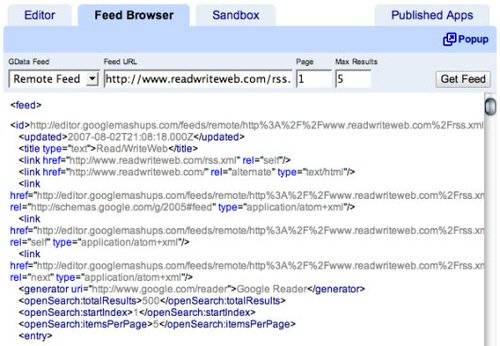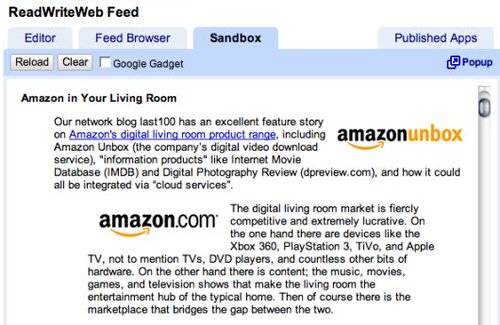I just got in to the shiny new beta for the Google Mashup Editor and I wanted to share my thoughts on it with you. Like Yahoo! Pipes before it (our review here), the Google Mashup Editor provides a simple interface that enables developers to make basic web applications and mashups quickly. And again, like Yahoo! Pipes, it is very definitely aimed at developers.

The idea behind it is to provide a rapid development framework for mashing feeds into Google services, using common technologies such as XML, JavaScript, CSS and HTML. It also offers a JavaScript API for more advanced behavioral interactions. Google describes the Mashup Editor as “a great tool for grabbing information from feeds and letting users see and manipulate it.”
Google Mashups Editor, showing code for a ‘Hello, World’ application.

Documentation
For keen developers who haven’t yet received access to the beta, there is a strong set of resources you can use to start learning the GME application functionality, structure, code and controls that don’t require a login. Ample documentation is available, including a diagram of the application structure and a comprehensive tag reference. Typical of Google, the documentation is the bare necessities, without even a index of the listed tags at the top of the reference page. Also, there is currently a short list of articles & tutorials, a FAQ, the official project blog, and, of course, a Google Group.
Components
The application itself is divided into 3 main parts: the Editor, Feed Browser and Sandbox. A screenshot of each is included in this article.
The Editor is for building projects. Each project can have multiple GML files (I’d guess that stands for Google Markup Language, but it’s not documented), and you can also upload resource files such as JavaScript or images. Each GML file can contain a mix of XML, HTML, JS, CSS and the GME tags. The examples don’t encourage good coding practices, but at least you have a lot of flexibility with how you code the applications.
The GME Feed Browser, browsing the Read/WriteWeb feed.

The GME Feed Browser is a convenient tool for checking your source feeds. You can use Google Base, or external feeds that you source yourself. The documentation frequently suggests using Yahoo! Pipes to clean up feeds before bringing them into GME. It offers some simple options for choosing the maximum number of results and pages you want returned.
The Sandbox is the simplest of the GME components. It’s a running version of your applications. Just hit ‘Test’ in the Editor and, after a sluggish pause, you’re automatically delivered to the Sandbox where your application begins running. You can test all functionality and see how your app will look. It also offers a simple option for viewing it as a Google Gadget.
The GME Sandbox, displaying a quick basic app I wrote for reading Read/WriteWeb feeds.

Publication
Publishing is as simple as pressing a button and choosing a name for your application. That name becomes the subdomain at googlemashups.com, such as this sample application at http://mapwiki.googlemashups.com/. Google curates a full gallery of other mashups. Getting your mashup live and into that gallery as quickly as possible will result in massive exposure – the balance will be making sure it’s good enough to stand out.
Conclusion
The Google Mashup Editor is an incredibly powerful tool for rapid testing and deployment of mashup concepts, particularly those that utilize Google services or products. This opens the space to all those developers who don’t have their own servers to play on and gives them a framework to kickstart development. It’s simple easy and fun to produce something very quickly, but it will be much harder to produce fantastic products. Nonetheless, the cost-savings in development time are going to make this a popular testbed for all sorts of concepts. Google Mashup Editor is a name you will hear a lot in future.





















